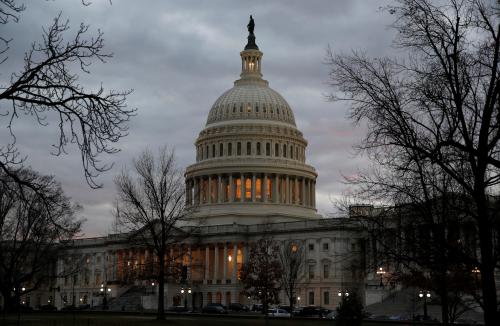The prospects for another stimulus bill and a pending Supreme Court nomination have captured the congressional headlines in recent weeks, but, behind the scenes, a group of House members—the Select Committee on the Modernization of Congress—has been working hard to improve the functioning of the House of Representatives. The panel released their final round of recommendations last week, bringing to 97 the number of proposals the bipartisan panel has advanced since 2019. Among this most recent set of recommendations is one with potential to invigorate both the power of Congress as an institution and of its individual members: an outline of a new Community Focused Grant Program through which legislators could help direct federal resources to their states and districts.
The framework sketches out the following parameters for a new approach to directing congressional spending. Public entities (including public-serving non-profits) and state, local, and tribal governments would submit applications to a member of Congress; legislators would choose which projects to endorse and would submit those the relevant congressional committee. A standardized grant application would be developed, but individual representatives would be given latitude to develop their own processes for vetting the requests submitted to their offices. Members would be encouraged, however, to establish procedures that would engage local elected officials and stakeholders, such as economic development groups, and to collaborate with their colleagues on requests that would affect multiple districts. Requests would be submitted via a common, publicly-accessible website to the relevant congressional committee—such as the Committee on Transportation and Infrastructure for highway projects—and committees would be directed to balance the needs of rural and urban districts in awarding grants in the legislation they oversee. The proposal also includes requirements for transparency and for an overall cap on the amount of federal spending that could be allocated via these new grants. Part of that transparency and additional safeguards work to make sure that legislators and their spouses do not see personal, financial benefit from the selection and awarding of those funds.
By creating a transparent and accountable process for the manner in which a portion of federal spending is allocated, to whom it is allocated, who requested the funding, and how that funding will be used, the Community Focused Grant Program would confer real institutional benefits to Congress. Significant parts of the U.S. Constitution underpin of this effort. The Founders recognized that Congress—and especially the House—would have the smallest constituencies and be most directly connected to the people and their needs. As a result, the Constitution empowers Congress to have the appropriations power, and more specifically, for spending bills in Congress to originate in the House of Representatives.
Our Founders recognized the importance of input from national legislators in the determination of how funding is best allocated. Over the last decade, a series of changes in Congress has violated that connection and removed spending power from Congress. That power, instead, was transferred to political appointees and bureaucrats in the executive branch. The Community Focused Grant Program seeks to empower voters’ representatives in Washington and return a part of the operations of Congress to their original design and intent.
Beyond helping Congress fulfill its basic constitutional responsibility to hold the reins of federal spending, allowing individual members to have more say in how federal dollars are spent in their districts also has the potential to create a healthier institution by changing individual member behavior. In an institution where major legislation is often negotiated centrally by party leaders in the two chambers, individual legislators often feel like they have little ability to influence what happens in Washington. A transparent and consistent process for allocating resources to individual districts would make members feel more like they matter—which, in turn, could help them invest more in their legislative careers. The program would also empower members of Congress to help their constituents. Rather than anonymous bureaucrats in executive branch agencies making every determination over the spending of federal tax dollars, legislators—who know their district’s and state’s needs better than anyone in Washington—will play a role in those determinations. Third, the proposal encourages members to work with other members within their states, across state lines, and even across party lines to engage on projects that affect multiple constituencies. Such cooperation by design could affect how some members engage with their colleagues, growing familiarity through shared need and accomplishment.
While the Committee’s recent action does not launch the new program, it does lay important groundwork should the next Congress wish to implement the proposal. By doing the hard work of reaching bipartisan agreement on a plan to empower legislators to help their districts, the Select Committee has set the House up to make real change that benefits both individual members and the institution as a whole.
Note: The authors of this post have given formal testimony to and also briefed the Select Committee on the Modernization of Congress on this and other topics.
This work is licensed under the Creative Commons Attribution-NonCommerical-NoDerivatives 4.0 International License. To view a copy of the license, visit https://creativecommons.org/licenses/by-nc-nd/4.0/.
The Brookings Institution is committed to quality, independence, and impact.
We are supported by a diverse array of funders. In line with our values and policies, each Brookings publication represents the sole views of its author(s).









Commentary
How a proposed House reform would flow federal funding into communities
September 30, 2020